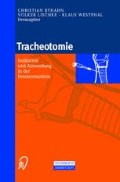Zusammenfassung
Die endotracheale Intubation stellt das am häufigsten angewendete Verfahren zur Schaffung eines sicheren Atemwegs dar. Nahezu jeder Patient wird zur Durchführung einer Beatmungstherapie primär endotracheal intubiert, wobei Praktikabilität, Schnelligkeit und die hohe Sicherheit für die Wahl dieses Verfahrens ausschlaggebend sind. Die erwartete Dauer der intensivmedizinischen Beatmungstherapie beeinflußt diese Entscheidung üblicherweise nicht. Im mittel- und langfristigen Atemwegsmanagement stellt die translaryngeale Intubation jedoch ein Verfahren dar, das aufgrund seiner direkt mit der Anwendungsdauer korrelierten Komplikationsrate kritisch betrachtet werden muß [38].
Access this chapter
Tax calculation will be finalised at checkout
Purchases are for personal use only
Preview
Unable to display preview. Download preview PDF.
Literatur
Bach A, Boehrer H, Schmidt H, Geiss HK (1992) Nosocomial sinusitis in ventilated patients. Anaesthesia 47:335–339
Bause H, Prause A (1997) Alternative Atemwege. Anästhesiol Intensivmed Notfallmed Schmerzther 33:501–504
Bause H, Prause A (1997) Indikationen, Kontraindikationen und Komplikationen der Dilatationstracheotomie nach Ciaglia. In: Deutsche Akademie für anästhesiologische Fortbildung (Hrsg.) Aktuelles Wissen für den Anästhesisten: Refresher Course. Springer, Berlin Heidelberg New York, S 155–164
Betbese AJ, Perez M, Bak E, Rialp G, Mancebo J (1998) A prospective study of unplanned endotracheal extubation in intensive care unit patients. Crit Care Med 26:1180–1186
Bishop MJ, Hibbard AJ, Fink BR, Vogel AM, Weymuller EA (1985) Laryngeal injury in a dog model of prolonged endotracheal intubation. Anesthesiology 62:770–773
Bishop MJ (1989) Mechanisms of laryngotracheal injury following prolonged tracheal intubation. Chest 96:185–186
Bryant LR, Trinkle JK, Mobin-Uddin L, Baker J, Griffen WO Jr (1972) Bacterial colonization profile with tracheal intubation and mechanical ventilation. Arch Surg 104:647–651
Byhahn C, Rinne T, Halbig S, Albert S, Lischke V, Westphal K (1999) Frühelektive perkutane Tracheotomie nach medianer Sternotomie. Z Herz Thorax Gefäßchir 13:221–227
Callanan V, Gillmore K, Field S, Beaumont A (1997) The use of magnetic resonance imaging to assess tracheal stenosis following percutaneous dilatational tracheostomy. J Laryngol Otol 111:953–957
Christie JM, Dethlefsen M, Cane RD (1996) Unplanned endotracheal extubation in the intensive care unit. J Clin Anesth 8:289–293
Colice GL (1992) Resolution of laryngeal injury following translaryngeal intubation. Am Rev Respir Dis 145:361–365
Durbec C, Albanese J, Martin C (1992) Requirement and design of endotracheal tubes. In: Cros AM, Janvier G (Hrsg.) Tracheal intubation. Pradel, Paris: 29
Durbin CG Jr (1999) Questions answered about tracheostomy timing? Crit Care Med 27:2024–2025
El-Naggar M, Sadagopan S, Levine H, Kantor H, Collins VJ (1976) Factors influencing choice between tracheostomy and prolonged translaryngeal tracheostomy in acute respiratory failure: A prospective study. Anesth Anaig 55:195–201
Gazzon AA, Seltzer B, Karlson KE (1963) Influence of tracheostomy tube size on work of breathing. Surg Forum 14:219
Grillo HC (1982) Primary reconstruction of airway after resection of subglottic and upper tracheal stenosis. Ann Thorac Surg 33:3–18
Grillo HC, Donahue DM, Mathisen DJ, Wain JC, Wright CD (1995) Postintubation tracheal stenosis. J Thorac Cardiovasc Surg 109:486–493
Healy GB (1989) Subglottic stenosis. Otolaryngol Clin North Am 22:599–606
Heffner JE, Miller KS, Sahn SA (1986) Tracheostomy in the intensive care unit. Part 1: Indications, technique, management. Chest 90:269–274
Heffner JE, Miller KS, Sahn SA (1986) Tracheostomy in the intensive care unit. Part 2: Complications. Chest 90:430–436
Holdgaard HO, Juhl B, Meisen MC, Pedersen J, Schrizek BA (1993) Complications and late sequelae following nasotracheal intubation. Acta Anaesthesiol Scand 37:475–480
Holzapfel L, Chevret S, Madinier G, Ohen F, Demingeon G, Coupry A, Chaudet M (1993) Influence of long-term oro-or nasotracheal intubation on nasomaxillary sinusitis and pneumonia: Results of a prospective, randomized, clinical trial. Crit Care Med 21:1132–1138
Kollef MH, Ahrens TS, Shannon W (1999) Clinical predictors and outcomes for patients requiring tracheostomy in the intensive care unit. Crit Care Med 27:1714–1720
Law RC, Carney AS, Manara AR (1997) Long-term outcome after percutaneous dilatational tracheostomy. Anaesthesia 52:51–56
Lesnik I, Rappaport W, Fulginiti J, Witzke D (1992) The role of early tracheostomy in blunt, multiple trauma. Am Surg 58:346–349
Plost J, Campbell SC (1984) The non-elastic work of breathing through endotracheal tubes of various sizes (Abstract). Am Rev Respir Dis 129:A106
Plummer AL, Gracey DR (1989) Consensus conference on artificial airways in patients receiving mechanical ventilation. Chest 96:178–180
Richards MJ, Edwards JR, Culver DH, Gaynes RP (1999) Nosocomial infections in medical intensive care units in the United States. Nosocomial Infections Surveillance System. Crit Care Med 27:887–892
Rodriguez JL, Steinberg SM, Luchetti FA, Gibbons KJ, Taheri A, Flint LM (1990) Early tracheostomy for primary airway control in the surgical critical care setting. Surgery 108:655–659
Rosenbower TJ, Morris JA, Eddy VA, Ries WR (1998) The long-term complications of percutaneous dilatational tracheostomy. Am Surg 64:82–87
Shapiro M, Wilson RK, Cesar G, Bloom K, Teangue RB (1986) Work of breathing through different sized endotracheal tubes. Crit Care Med 14:1028–1031
Steen JA, Lindholm CE, Brodlik GC, Foster CA (1982) Tracheal tube forces on the posterior larynx: Index of tracheal load. Crit Care Med 10:186–189
Tasota FJ, Hoffman LA, Zullo TG, Jamison G (1987) Evaluation of two methods used to stabilize oral endotracheal tubes. Heart Lung 16:140–146
Tindol GA Jr, DiBenedetto RJ, Kosciuk L (1994) Unplanned extubations. Chest 105:1804–1807
Vassal T, Anh NG, Gabillet JM, Guidet B, Staikowsky F, Offenstadt G (1993) Prospective evaluation of self-extubation in a medical intensive care unit. Intensive Care Med 19:340–342
Westphal K, Byhahn C, Lischke V (1999) Die Tracheotomie in der Intensivmedizin. Anaesthesist 48:142–156
Weymuller EA, Bishop MJ, Fink BR, Hibbard AW, Spelman FA (1983) Quantification of intralaryngeal pressure exerted by endotracheal tubes. Ann Otol Rhino Laryngol 92:444–447
Whited RE (1984) A prospective study of laryngotracheal sequelae in long-term intubation. Laryngoscope 94:367–377
Wood DE, Mathisen DJ (1991) Late complications of tracheostomy. Clin Chest Med 12:597–609
Editor information
Editors and Affiliations
Rights and permissions
Copyright information
© 2000 Springer-Verlag Berlin Heidelberg
About this chapter
Cite this chapter
Byhahn, C. (2000). Indikation und Zeitpunkt der Tracheotomie in der Intensivmedizin. In: Byhahn, C., Lischke, V., Westphal, K. (eds) Tracheotomie. Steinkopff, Heidelberg. https://doi.org/10.1007/978-3-642-57702-4_3
Download citation
DOI: https://doi.org/10.1007/978-3-642-57702-4_3
Publisher Name: Steinkopff, Heidelberg
Print ISBN: 978-3-642-63328-7
Online ISBN: 978-3-642-57702-4
eBook Packages: Springer Book Archive

